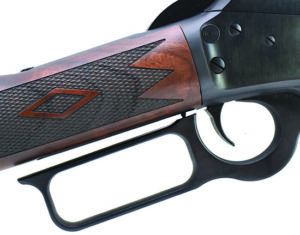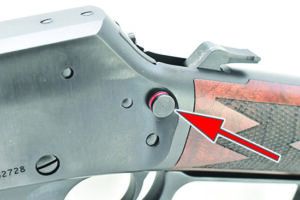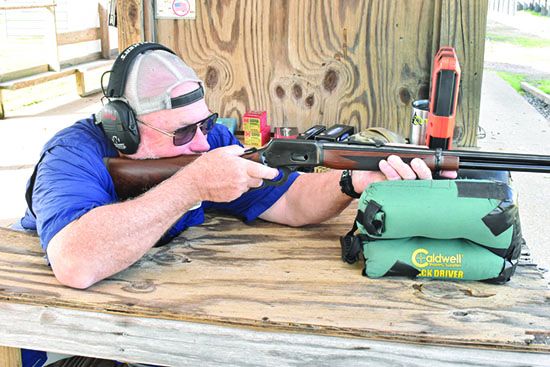We’ve seen at least three changes in Marlin Firearm’s ownership over the decades, with the last coming when Remington Outdoor Co., which owned Marlin’s assets, filed for its second bankruptcy in July 2020. Shortly thereafter, Sturm, Ruger & Co. saw an opportunity and bought Marlin in November 2020, purchasing the Marlin name and all the tooling. The last of the Remington/Marlin-made rifles had a reputation for problems and poor accuracy. We wanted to see if Ruger properly addressed those issues, and if shooters who had been scared off by some of the reports from years ago needed to reconsider buying a redesigned Marlin.
One of the Marlin lines Ruger reintroduced is the Model 1894 Classic. We found a Ruger-made Marlin 1894 Classic in 44 Special/44 Remington Magnum Model No. 70401 for $1019 in late 2023. We also managed to obtain a sample of the just-released Smith & Wesson 1854 Lever Action Rifle, also in 44 Mag. This rifle is so new that we could only find the suggested list price of $1279, but store pricing was still unavailable. We saw one site listing them at just under $3100. Being an early adopter in the gun market can be painful.
All the initial shooting was done with the factory-installed sights. For the Marlin, that meant we were using a buckhorn-style rear sight. The Smith & Wesson 1854 ships with peep sights installed, so we were able to test using its great sights from the beginning. We wondered what the Marlin could do with an optic on top, so we also fired it with a Crimson Trace red dot, which was easy to install.
Also, to see how much Ruger had changed the Marlin 1894, we fired a 2008 version side by side with the Ruger-Marlin Classic tested here. Be sure to check out Gun Tests+ online for more on the Legacy 1894. Here’s how the two lever-action rifles performed at the range:
Marlin Model 1894 Classic 70401 44 Special/44 Remington Magnum
$1019
Gun Tests grade: B+
Ruger took a great rifle and made it better. Ruger has shown outstanding judgment in placing Skinner Sights on a number of their lever guns. We’d love to see them come from the factory on this model.

| Action Type | Lever |
| Overall Length | 37.6 in. |
| Barrel Length, Twist | 20.25 in., 1:20 in. |
| Overall Height w/o Scope Mount | 7.75 in. |
| Weight Unloaded | 6.3 lbs. |
| Weight Loaded | 6.9 lbs. |
| Sight Radius | 16.5 in. |
| Action Finish | Satin Blued |
| Barrel Finish | Satin Blued |
| Magazine Capacity | 10 (44 Mag.); 11 (44 Sp.) |
| Magazine Type | Underbarrel tube |
| Stock | Black walnut |
| Stock Drop at Comb | 1.0 in. |
| Stock Drop at Heel | 1.7 in. |
| Stock Buttplate | Rubber |
| Stock Length of Pull | 13.63 in. |
| Fore End Bedding | NA |
| Receiver Scope-Base Pattern | Marlin 1894 |
| Trigger Pull Weight | 4.29 lbs. |
| Safeties | Hammer and crossbolt |
| Warranty | None written |
| Telephone | (336) 949-5200 |
| Website | MarlinFirearms.com |
| Made In | U.S. |
After the folks at Sturm, Ruger purchased the Marlin brand, they reportedly transferred more than 100 truckloads of parts and product to their factory. Many of the machines were ancient, the tooling was worn out, and drawings were missing or out of date, leaving Ruger the daunting prospect of getting the 1894 rifle line back into production.

Many of the features of the new Ruger/Marlin (hereafter, we’ll just call it a Marlin) are the same, and we’ll discuss those shortly. But we knew there had been many changes in the engineering of the new model, and we wanted to know what some of those were. With that in mind, we talked with Eric Lundgren, the Ruger product manager in charge of the Marlin line.
We’ve tested many rifles, some of them very reasonably priced, and found many samples that would shoot sub-MOA at 100 yards. Yet, most folks seem to be pleased with 2- or 3-inch groups at 50 yards with a lever gun, and we wondered why. We discussed tolerance stacking issues with these rifles and all their moving parts. Lundgren also brought up a simple point we’d never considered — we see all kinds of “Match” ammo for bolt guns. When was the last time you saw “Match” 44 Mag or 357 Mag ammo? Just try some cheap NATO-spec 147-grain FMJ 7.62 ammo in that nice 308 of yours and see what happens to the group sizes.
Lundgren also mentioned the changes in rifling for the Marlins over the years. According to William S. Brophy’s book, Marlin Firearms: A History of the Guns and the Company, most of the early Marlins were rifled by drilling the bore and then cutting the rifling one groove at a time on a sine-bar machine. Also known as Ballard rifling, the process was effective but slow and, therefore, costly. Later models used a very shallow rifling known as Microgroove. It worked well with jacketed bullets, but was lacking when it came to cast rounds. The current Marlins utilize Ruger’s cold-hammer-forged method, which has provided some superb groups in the Ruger American Rifles we’ve tested. Twist rates have been increased, and the chamber specifications have been tightened a bit since our sample was produced, a change that has produced even tighter groups in their tests.

We have been extremely pleased with our stock. Our sample shows some excellent figure, but others we have seen don’t quite hold up to this standard. That said, every other example we’ve seen has been an improvement over a Legacy Marlin we had on hand. The Classic’s American black walnut is dark, with nice grain and cleanly cut. Wood-to-metal finish is quite good, and Lundgren told us this is another place that had to be re-engineered. In previous models, the fit was such that most of the rearward energy from recoil was directed down the tang and impacted the top rear of the pistol grip. This design has all the force impinging on a very small area, sometimes leading to fractured stocks. The new model was changed so that most of the impact occurred at the junction of the forward end of the stock and the sides of the receiver, thus spreading that recoil collision over a much wider area.
We noticed a few other, subtle changes. The fore end has been reshaped to a slimmer profile that feels great in the hand. The fore end cap that bore against the barrel has been deleted. In its place, we see a solid wood fore end with a barrel band that has been moved slightly to the rear. Those accustomed to vintage Marlins will remember the black-and-white bullseye emblem inlet into the stock immediately in front of the rear sling swivel stud. Ruger did the same thing with the new Marlin but changed the colors to red and white to go with the Sturm, Ruger logo.
Disassembly of this lever gun is one of the advantages it has over its competitors. Simply remove the hinge screw on the lever, move the lever forward about halfway, and draw it down and out of the receiver. The bolt can then be removed to the rear. Be aware the ejector is held in the receiver by the bolt. Remove it by hand and remember to reinsert before sliding the bolt back in. This simple procedure allows the barrel to be cleaned from the breach end, a method that is less likely to damage the crown at the muzzle. We also noticed that the crown is now chamfered slightly, further decreasing the likelihood of damage while in use or while being cleaned.
As noted, we modified the sighting system and performed a second shooting test looking for improvement over the first series. The sight we chose was a Crimson Trace RAD (Rapid Aiming Dot) Pro 01-01940, $269 from OpticsPlanet.com. The RAD has a 3-MOA red dot and may be designed for a pistol, but it also comes with a low mount designed to attach to a Picatinny rail. We bought a Midwest Industries Picatinny rail (No. 720836, $37, MidwayUSA.com) and attached it to the Marlin along with the Crimson Trace sight. The result was a substantial improvement in speed and accuracy while maintaining a very low profile on the rifle and adding only 3.7 ounces. Shouldering the rifle was a bit more difficult, with a proper cheek weld no longer possible because of the added height. Still, we were able to achieve a good solid chin weld and all worked fine. The result of adding the Crimson Trace dot was a 53% reduction in group size at a mere 0.96-inch average.
Our Team Said: Feeding was smooth with every type of ammo tested, even the shorter 44 Specials, except for the 320-grain hardcast flatnose bullet from Doubletap. That round generated almost 1900 foot-pounds of energy and averaged 2.2-inch groups. The favorite load in this rifle was the Black Hills ammo, compiling an average of 2.05 inches. That was also with a not-so-good group, though we didn’t call a flier, so we included it in the numbers. Otherwise, the Black Hills 240-grain JHPs shot less than an inch and a half at 50 yards.
| 44 MAGNUM RANGE DATA | ||
| Hornady Handgun Hunter 200-grain Monoflex | Marlin 1894 Classic | S&W Model 1854 |
| Average Velocity | 1622 fps | 1680 fps |
| Muzzle Energy | 1169 ft.-lbs. | 1253 ft.-lbs. |
| Best Group | 1.77 in. | 1.91 in. |
| Average Group | 2.4 in. | 2.29 in. |
| Black Hills 240-grain JHP | Marlin 1894 Classic | S&W Model 1854 |
| Average Velocity | 1655 fps | 1676 fps |
| Muzzle Energy | 1460 ft.-lbs. | 1496 ft.-lbs. |
| Best Group | 1.37 in. | 1.53 in. |
| Average Group | 2.05 in. | 1.55 in. |
| Doubletap Ammunition 320-grain Hard Cast | Marlin 1894 Classic | S&W Model 1854 |
| Average Velocity | 1626 fps | 1663 fps |
| Muzzle Energy | 1879 ft.-lbs. | 1964 ft.-lbs. |
| Best Group | 1.58 in. | 1.98 in. |
| Average Group | 2.24 in. | 2.36 in. |
We conducted our tests at American Shooting Centers in Houston. At 50 yards, we fired multiple three-shot groups for accuracy from a well-sandbagged Caldwell TackDriver Pro rest (Brownells 100-027-023, $49), further supported by a large rear bag, heavy from Tab Gear (TabGear.com, $34). Our 44 Remington Magnum loads covered the weight and power spectrum with Hornady Handgun Hunter 200-grain Monoflex all-copper rounds, Black Hills Factory New 240-grain JHPs, and Doubletap 320-grain Hardcast Solid lead cartridges. We did function testing with a surplus of 44 Magnum reloads we had on hand.
Written and photographed by Joe Woolley, using evaluations from Gun Tests Team members. GT


























